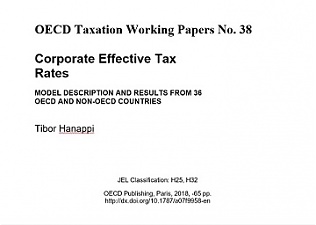Analytics, Book review, EU – Baltic States, Financial Services, Taxation
International Internet Magazine. Baltic States news & analytics
Sunday, 07.12.2025, 07:02
New OECD’s attempt to create universal corporate tax rates
 Print version
Print version |
|---|
Experts from OECD have acknowledged existing variations in
the definition of the corporate tax base across countries, which are having significant
impacts on tax liabilities associated with possible rate of investment. An
accurate assessment of the effects of corporate income tax systems (CIT) on
investment thus needs to build on a consistent methodological framework
covering not only statutory tax rates but also many provisions affecting the
base such as fiscal depreciation. A new OECD paper prepared by T. Hanappi
provides such a framework*).
*) Hanappi, T. (2018), "Corporate Effective Tax
Rates: Model Description and Results from 36 OECD and Non-OECD
Countries", OECD Taxation Working Papers, No. 38, OECD
Publishing, Paris, in https://doi.org/10.1787/a07f9958-en.
The OECD model**) is built on the theoretical provisions developed
by Devereux and Griffith (1999, 2003), which present forward-looking effective
tax rates (ETRs) for 36 OECD and so-called “selected partner economies” taking
into account a wide range of corporate tax provisions.
**) See in: https://www.oecd-ilibrary.org/taxation/corporate-effective-tax-rates.
The OECD paper consists of five sections and appendixes. In
first two an overview is provided with the main concepts and earlier contributions
to the methodology as well as more recent applications in policy analysis. Section
2 introduces a short description of other publicly available ETR databases,
highlighting some of the differences to the OECD model.
Section 3 contains a formal description of the model based
on the standard approach developed by Devereux and Griffith (1999, 2003).
Section 4 discusses country-specific corporate tax features that
have been implemented in some countries but not necessarily in the all
participating countries. Finally, Section 5 presents the ETRs for the full set
of 36 countries based on tax rules as of July 2015 with some empirical results.
Out of three Baltic States only Estonia participated in the OECD analysis.
A model for a perspective CIT: two scenarios
The paper presents the new OECD model for the calculation of
forward-looking effective tax rates and provides first empirical results based
on an OECD survey, conducted in 2016, collecting comparable cross-country
information on corporate tax provisions from 36 OECD and Selected Partner
Economies.
The empirical results discussed in this paper highlight that
an accurate assessment of investment incentives across countries needs to build
on a consistent methodological framework capable of covering not only corporate
statutory tax rates but also many different rules that affect the tax base such
as fiscal depreciation and other deductions or allowances.
The OECD corporate effective tax rate model described in
this paper is based on the theoretical model developed by Devereux and Griffith
(1999, 2003) and currently covers 10 asset categories and 36 different
corporate tax systems in the world.
Empirical results (formulated at 19 pages; the rest 45 pages
are “model files”) are based on two different macroeconomic scenarios, showing
that effective average and marginal tax rates vary widely across asset
categories, countries and sources of finance. In addition to the cross-country
comparative analysis presented below, the OECD model also enables researchers
to conduct further cross-country and within-country analyses of the incentive
effects of corporate and personal income taxation.
Two types of ETRs
The paper distinguishes two types of effective tax rates:
- Effective marginal tax rates (EMTRs)
measure the extent to which taxation increases the pre-tax rate of return
required by investors to break even. This indicator is used to analyse
investment decisions at the intensive margin, i.e. to assess how taxes affect
the incentive to expand investment given a fixed location. The EMTR is the tax
component of the user’s cost of capital.
- Effective average tax rates (EATRs)
measure the effect of taxation on investment projects earning economic rents;
it is based on a comparison of the net present value of pre-tax and post-tax
cash flows. This indicator is used to analyse investment decisions at the
extensive margin, i.e. “location decisions”, when a multinational enterprise
(MNE) decides to locate a plant in one of many jurisdictions, or make one of a
number of technology choices. (p.5)
The appendix in the paper describes in detail how the OECD
model can be used for policy analysis. It includes several examples and
illustrates how country-specific policy evaluations can be conducted.
The results highlight the fact that the definition of the
tax base, that is, fiscal depreciation rules and other corporate tax
provisions, is crucial for comparative analyses of effective taxation. That means
that reaching a correct assessment of the investment incentives of corporate
tax systems across countries it is necessary to account for tax bases and rates
within a consistent framework.
The ETRs derived through the new OECD model provide such a
framework, incorporating a wide range of generic and country-specific tax
provisions.
The OECD model, therefore, enables researchers to conduct
cross-country and within-country, as well as cross-asset analyses aimed at many
relevant policy questions, such as for example, the evaluation of how the tax
system provides incentives to invest in one type of asset versus another (p.23).
It has to be said that the OECD paper will be read with
interest by all those who are interested in taxation issues, in particular by
the tax authorities in the Baltic States, which are involved in the attracting
foreign investment’s policies.








 «The Baltic Course» Is Sold and Stays in Business!
«The Baltic Course» Is Sold and Stays in Business!

